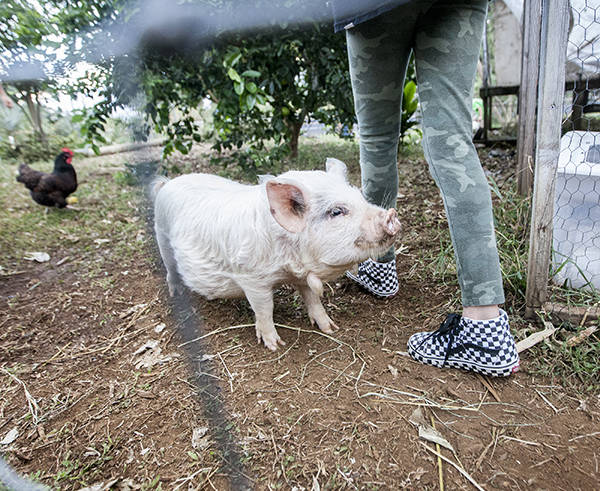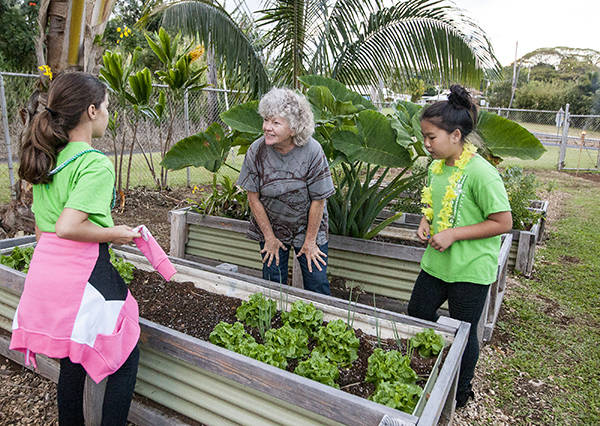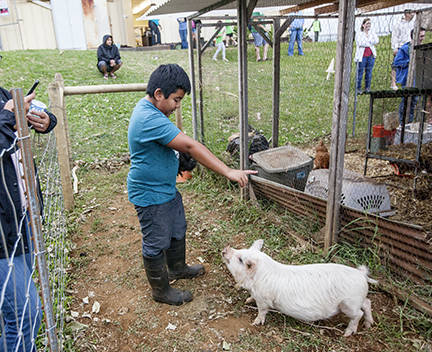Students at Papaikou school learn lessons from the land



It was quiet and peaceful Monday morning in the Prince Jonah Kuhio Kalanianaole Elementary and Intermediate Schools garden in Papaikou save for a frequent rooster crow and rumbling of a passing car.
It was quiet and peaceful Monday morning in the Prince Jonah Kuhio Kalanianaole Elementary and Intermediate School’s garden in Papaikou — save for a frequent rooster crow and rumbling of a passing car.
Although the garden, Ulu E‘a, started in 2006, work over the past few years has transformed the space.
ADVERTISING
On top of the hill, there are raised garden beds, built by students, growing green goods and plots of sugar cane, kalo and more. A greenhouse is under construction.
In pens down the hill were two kunekune pigs, chickens and a therapy rabbit. Nigerian dwarf goats joined the motley crew later that day.
Garden educator Donna Mitts said the recent effort to clean up and develop the once-overgrown garden began two years ago.
Kenneth Love, the full-time garden teacher and physical education teacher, said there had been several garden teachers at the school through the years and prior to his arrival, but after the last teacher left, there was a lapse in caretakers.
During his first year at the school, Love, then a second-grade teacher, took his students to visit the garden, which then had an agroforestry focus, before a field trip. He saw the students’ enthusiasm.
“Then the garden teacher allowed me to have a little bed,” he said. The class planted pineapples, and Love said he taught a range of subjects on that plot of land.
“That little bed yielded so many results.”
When, for instance, the class struggled with the concept of inches and centimeters, Love said they found, and were able to measure, a worm.
That “clicked” with the students, and Love said he was “able to teach, math, science and social studies in one lesson.”
Mitts said she and Love started working together and “just tackled” the garden along with the help of parents and volunteers.
The last school year was the first year Mitts had twice-a-week classes with kindergarten through fifth-grade students.
“We would come out in the garden and do projects at that time,” Mitts said. “Mr. Love was still a second-grade teacher, but he was very active in the garden, and he would bring his students out.”
Mitts continues to work part-time at the school, but prior to that worked with the Hawaii Island School Garden Network, a program of the Kohala Center. The Kalanianaole garden was one of the school gardens she oversaw and helped support.
“For me, school gardens are really an important opportunity for students to learn about where their food comes from and healthy eating and how to grow food.”
Love brought in the animal component, first hatching chickens in his classroom.
A few months ago, the kunekune pigs were donated. Love had wanted kunekune pigs for their docile nature, size and grazing habits.
He wanted students “to be able to communicate with something that is different than them.”
The garden has a diverse offering including herbs like basil, chives, oregano and thyme, peppers, tomatoes, cauliflower, cassava, cocoyam, sugar cane, citrus trees and even orchids.
Plants grown there are either “canoe plants” or indigenous to Hawaii, said Love.
According to Love, everything that’s done in the garden is done by the students, who built raised garden beds and animal enclosures, planted and mulched, and even tilled the earth.
Students learn how to use the tools — then use them.
“They’re gardeners, through and through.”
On Tuesday, a handful of students said they were excited about their work in the garden and with the animals.
When asked if they like being able to work outside, a small group of students responded with a resounding “yes!”
“It’s fun, and we get to interact with the animals,” said fourth-grader Kysen Taniguchi, 9.
Likewise, fellow fourth-grader Akoni Perry, 10, said garden classes are fun.
“My favorite part of the garden is being able to learn about plants and animals, but my most favorite part is interacting with my friends and with the garden,” he said.
Sixth-grade student Mercy Northrop, 11, also liked working with the animals, as well as working with friends.
“When we grow up, maybe we’ll know how to cook food and take care of animals,” fifth-grader Elena Dinkle, 10 said.
While the food they grow is not yet used in the school, “we want to eventually get there,” said Love, who has been certified through the Produce Safety Alliance so the garden can be qualified as a food producer.
At the time, however, Love said they can sample the foods, and Mitts said they want to include a culinary aspect to the garden program.
Mitts said the support for the garden from families and the community has been a pleasant surprise.
“The love and support we’ve been getting from our families and our community has been a wonderful way to help our program move forward.”
Email Stephanie Salmons at ssalmons@hawaiitribune-herald.com.


